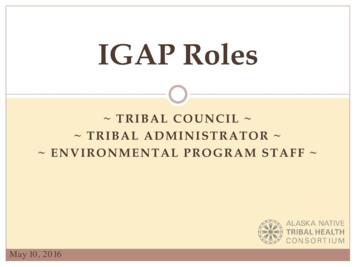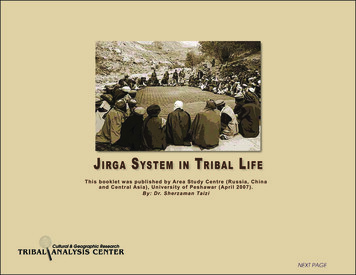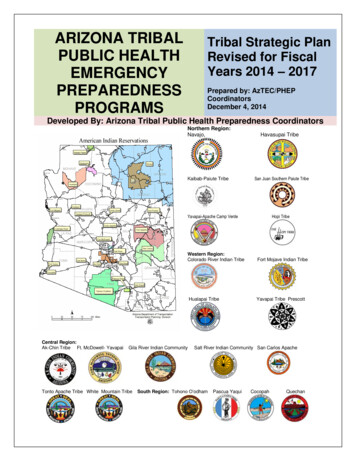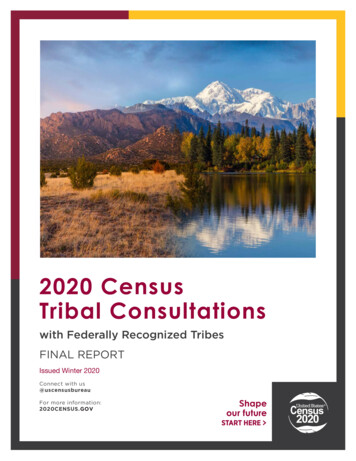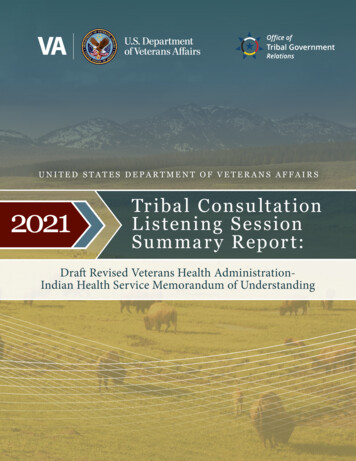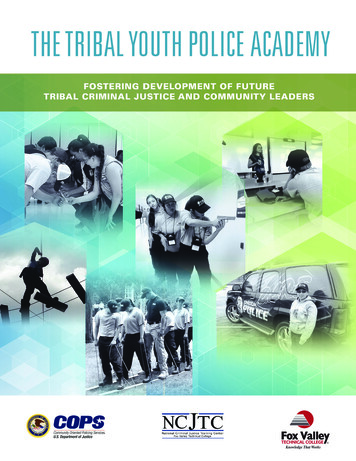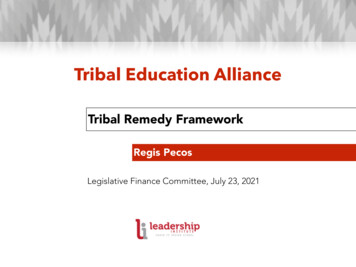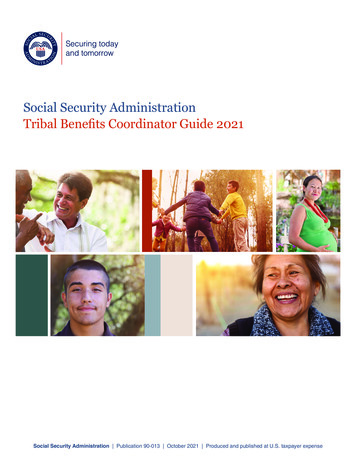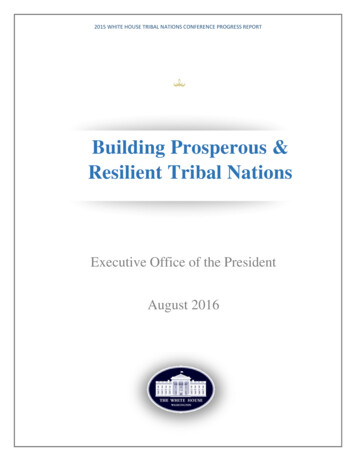
Transcription
2015 WHITE HOUSE TRIBAL NATIONS CONFERENCE PROGRESS REPORTBuilding Prosperous &Resilient Tribal NationsExecutive Office of the PresidentAugust 20161
2015 WHITE HOUSE TRIBAL NATIONS CONFERENCE PROGRESS REPORTTable of ContentsExecutive Summary . 6Expanding and Improving Opportunities for Native Youth . 8White House Tribal Youth Gathering. 9National Intertribal Youth Summit . 9FEMA Corps Program . 9The Tribal Maternal, Infant and Early Childhood Home Visiting Program . 9The Department of Education and the White House Initiative on American Indian and Alaska NativeEducation (WHIAIANE) . 10Bureau of Indian Education (BIE) Reform . 11Bridging the Digital Divide in a Technology Economy. 12Recruiting Tribal Colleges to Address Environmental Issues . 12Washington Internships for Native Students Program . 12Federal Leadership Travels to Indian Country for Native Youth . 13Cultural Heritage Native Youth Program. 14Advancing the Nation-to-Nation Relationship: Treaty and Trust Responsibilities . 15Tribal Treaty Rights . 16Treasury Department Consultation Policy . 16Treasury Tribal Advisory Committee . 16Improving Consultation in Federal Project Planning . 17American Indian and Alaska Native Voting Rights . 17Updates to Federal Acknowledgment of Indian Tribes . 17Increasing Public Safety in Indian Country . 19Improving Federal Response to Sexual Assault . 20Supporting Tribes' Criminal Jurisdiction over Non-Indian Offenders in Domestic Violence Cases . 202
2015 WHITE HOUSE TRIBAL NATIONS CONFERENCE PROGRESS REPORTResponding to Human Trafficking among American Indian and Alaska Natives . 20The Blue Campaign . 22Helping Tribal Members Successfully Return to Their Communities after Incarceration . 22Increasing Tribal Access to National Crime Information Databases . 22Expansion of Interagency Indian Country Training . 23FBI Victim Assistance in Indian Country . 23FY 2015 Streamlined Grant Awards for Tribal Communities . 24Training for Tribal Criminal Justice Professionals . 24Training Tribal Governments in Disaster Management . 25Tribal Homeland Security Grant Program . 25Training for Emergencies . 25Federal Emergency Management Agency (FEMA) . 26Improving Nutrition, Healthcare, and Wellness . 27Federal Employee Health Benefits for Tribal Employees. 28IHS Successfully Implements Data Sharing Capabilities with the VA . 28HHS Arctic Council Activities . 28Support for Improved Tribal Behavioral Health with a Focus on Native Youth . 29Reducing Systemic Homelessness . 29HUD and VA Partner to Provide Tribal Housing and Urban Development – Veterans AffairsSupportive Housing (Tribal HUD-VASH) . 30HUD’s Contributions to Decent Affordable Housing and Thriving Communities . 30Coordinated federal support and partnership with tribal communities . 31Reaching Historic Settlements . 32Ramah Settlement. 33Chickasaw-Choctaw Settlement . 33Indian Water Rights Settlements . 33Promoting Clean Energy, Protecting Natural Resources, and Combating Climate Change. 34U.S. Department of Energy Releases Tribal Climate Vulnerabilities Report . 353
2015 WHITE HOUSE TRIBAL NATIONS CONFERENCE PROGRESS REPORTColumbia Basin Fish Accords. 35U.S. Department of Energy Increases Technical Support and Financial Resources . 36U.S. Forest Service Partners with Tribes to Address Climate Change . 36Local Environmental Observers (LEO) Network . 37GIS Mapping Tool Displaying National Forest and Tribal Lands . 37Tribal Nations Landing Page on the Climate Resilience Toolkit . 38USDA Provides Natural Resources Leadership to Tribal College and University (TCU) Students . 39Community-Based Climate Mitigation Strategies . 39Webinars on Renewable Energy . 40Technical Assistance . 40Sustaining Economic Development . 42Jobs Development . 43Offering Technical and Financial Assistance . 44Funding Infrastructure Improvements . 44Improving Transportation in Indian Country . 45Promoting Native American Small Business Creation, Development and Growth . 45Increasing Knowledge and Access to the Clean Energy Economy . 46Enhancing Land Management and Ownership . 47Restoring Tribal Homelands through the Land Buy-Back Program . 48Respecting Cultural Rights . 49Inter-Agency Sacred Sites Memorandum of Understanding . 50New NAGPRA Regulations . 50Promoting Native Language . 50Improving Federal Services to Indian Country . 51Native One Stop . 52Social Security Administration (SSA) Tribal Outreach. 52Distribution of Funds in Trust . 524
2015 WHITE HOUSE TRIBAL NATIONS CONFERENCE PROGRESS REPORT“While we cannot undo the pain and tragedy of the past, we can set out together to forge abrighter future of progress and hope across Indian Country and the entire American landscape.”-President Obama, November 2015President Obama during his trip to Alaska. September 2015.5
2015 WHITE HOUSE TRIBAL NATIONS CONFERENCE PROGRESS REPORTExecutive SummarySince taking office, President Obama has set a course toward building a stronger nation-tonation relationship with tribal nations and supporting tribal self-determination and prosperity.The President’s Budget proposals have strongly supported tribal nations as well as Federaltreaty and trust responsibilities to Native Americans through a wide range of direct services andfunding for programs administered by tribes.As the President looks ahead to hosting his eighth and final Tribal Nations Conference onSeptember 26, 2016, this progress report builds on conversations and recommendations fromthe 2015 Tribal Nations Conference and outlines the Administration’s work in Indian Country in2015.In 2015, the Administration continued to restore tribal homelands through the Land Buy-BackProgram for tribal nations and by taking land into trust. Since 2013, nearly 400,000 total acreshave been taken into trust as part of President Obama’s goal of placing half-a-million acres intotrust for tribes during his Administration. The Administration also took action to update andstrengthen rules that govern tribal sovereignty over tribal homelands. These regulationssupport economic growth by creating more efficient and effective land management systems.Under the President’s leadership, the federal government has continued paving the way for astronger nation-to-nation relationship with tribes by resolving longstanding disputes, includinga milestone 940 million proposed settlement to resolve disputed contract support costs and a 186 million tribal trust settlement with the Chickasaw and Choctaw nations. Since October2010, the Administration has resolved breach of trust claims with tribes totaling approximately 2.8 billion, in addition to the 3.4 billion Cobell Settlement resolving individual AmericanIndian trust mismanagement claims.President Obama visited the Choctaw Nation of Oklahoma in July 2015 to discuss the federalgovernment’s efforts to expand broadband access and narrow the digital divide. As one of thefirst Promise Zones designees, the Choctaw Nation has partnered with the federal governmentto jumpstart its economic development and community revitalization. In September 2015, the6
2015 WHITE HOUSE TRIBAL NATIONS CONFERENCE PROGRESS REPORTPresident traveled to Alaska to meet with Alaska Native communities and to reaffirm hissupport for tribal climate resilience and the protection of natural resources. The Administrationcontinues to strive to increase federal-tribal collaborations and develop tools to prepare for andaddress the impacts of climate change.The Administration remains committed to expanding and improving opportunities for Nativeyouth, particularly through the Generation Indigenous (Gen-I) initiative. Gen-I seeks to removethe barriers that stand between young people and opportunity, taking a comprehensive andculturally appropriate approach to ensuring all young Native people can reach their fullpotential. In July 2015, more than 1,000 Native youth gathered in Washington, D.C., for theinaugural White House Tribal Youth Gathering and were joined by First Lady Michelle Obama,Cabinet members, and members of Congress. This gathering focused on access to qualityeducation, as well as youth initiatives on leadership, community and cultural engagement, andtechnology.Throughout 2015, the Administration continued major initiatives supporting more resilient andprosperous tribal nations. The historic progress in the relationship between the federalgovernment and tribes will continue into President Obama’s final year in office with a newcharge – to ensure the accomplishments of this Administration achieved in collaboration withIndian Country grow and endure for many years to come.7
2015 WHITE HOUSE TRIBAL NATIONS CONFERENCE PROGRESS REPORTExpanding and Improving Opportunities for Native YouthThe President announced the Generation Indigenous (Gen-I) initiative in December of 2014 as away to improve the lives of Native youth through new investments and increased engagement.This initiative takes a comprehensive, culturally-appropriate approach to ensure that all youngNative people can reach their full potential. Highlights of Gen-I activities over the past year areoutlined in this section.President Obama speaking with Native youth while hosting the 2015 Tribal NationsConference.8.
2015 WHITE HOUSE TRIBAL NATIONS CONFERENCE PROGRESS REPORTWhite House Tribal Youth GatheringIn July 2015, tribal youth participated in the first-ever White House Tribal Youth Gathering,where over 1,000 young Native leaders (ages 14-24) from across the country gathered in a daylong convening to discuss an array of concerns in their tribal communities and across theNation. The objective of the convening was to give these young people the opportunity toshare with federal officials and each other the challenges they see in their own communitiesand, importantly, to talk about solutions – some of which a number of youth leaders hadimplemented in their own communities already. The event featured remarks from the FirstLady, Cabinet officials, and members of Congress.National Intertribal Youth SummitBeginning with a grant award in 2013, DOJ launched the NationalIntertribal Youth Leadership Development Initiative, known asToday’s Native Leaders (TNL), which consists of youth gatherings,opportunities, and services to develop leadership skills amongcohorts of tribal youth. Tribal youth also participated in the firstever White House Tribal Youth Gathering.Over 1,000 youngNative leadersgathered at theWhite HouseTribal YouthGathering.FEMA Corps ProgramActing on a commitment announced at the 2014 Tribal Nations Conference, the FederalEmergency Management Agency (FEMA) increased recruitment efforts in Indian Country for theFEMA Corps program (18 – 24 year olds) and saw a 400 percentincrease in American Indian and Alaska Native (AI/AN)Tribal applicationsapplicants. FEMA Corps expanded their recruitment throughfor the FEMA Corpsgreater outreach tribal conferences, promotional materials, andprogram increasedyouth outreach. FEMA Corps is a 10 month program that400% in the yearprovides training, experience, and educational opportunitiesthat will prepare hundreds of young AI/ANs and other youth for2015.careers in emergency management and related fields.The Tribal Maternal, Infant and Early Childhood Home Visiting ProgramThe Tribal Home Vesting (THV) Program, administered by the Department of Health and HumanServices (HHS), was launched in 2010 as part of the Affordable Care Act. The THV Program usesculturally responsive strategies to support pregnant women, expectant fathers, and parentsand caregivers on providing healthy, supportive, and enriching home environments for theiryoung children. This unprecedented expansion of culturally responsive services for AI/AN9
2015 WHITE HOUSE TRIBAL NATIONS CONFERENCE PROGRESS REPORTfamilies and children has served more than 1,500 families with nearly 20,000 home visits,across 25 tribal and American Indian or Alaska Native programs. In 2012, HHS also launched apartnership with tribes called the Tribal Early Learning Initiative, which aims to support tribes inimproving, growing, and sustaining their early childhood systems so that all young children intheir communities arrive at school ready to excel.The Department of Education and the White House Initiative on American Indian and AlaskaNative Education (WHIAIANE)The Department of Education has supported several programs and grant opportunities targetedto tribes and tribal communities, including the State-Tribal Education Partnership Program(STEP) and the Native American and Alaska Native Children in School Program. The Presidentrequested funding for STEP through his fiscal year 2012 budget request to Congress to establisha pilot program of competitive grants to tribal educational agencies (TEAs) to increase their rolein the education of American Indian and Alaska Native students. Owing to the success of theprogram, Congress provided additional funding for STEP in 2015.WHIAIANE, which is housed in the Department of Education, has worked to establish a dialoguewith Native communities as well. In 2014, WHIAIANE held nine Native Student EnvironmentListening Sessions in seven states from New York to California to Alaska; drawing more than1,000 participants, discussing issues ranging from bullying, student discipline, and potentiallyharmful Native imagery and symbolism, to the impact of these school climate issues. InOctober 2015, the Department of Education released the Student Environment ListeningSessions Final Report which identifies common issues and concerns shared by teachers,parents, community members, and students, and provides participants’ recommendations forhow federal, tribal, state, and local governments should address them.In addition to these new developments, longstanding commitments to improving Indianeducation have continued. One such example of this is the 2015 National Native LanguageRevitalization Summit, co-hosted by the Department of Education. The Summit is an annualgathering of tribal leaders and federal officials discussing language revitalization efforts meantto improve the quality and cultural competency of instruction for Native students in theclassroom.Additionally, in response to the President’s Generation Indigenous Initiative, established in2014, the Department of Education launched the Native Youth Community Partnership (NYCP)grants. NYCP supports tribally designed solutions that can improve college- and careerreadiness for Native youth. To support these efforts, the FY 2016 budget requested a total of10
2015 WHITE HOUSE TRIBAL NATIONS CONFERENCE PROGRESS REPORT 68 million for Special Programs for Indian Children, a 50 million increase from the 2015 level.Of this request, 52.9 million was requested for new and continuing NYCP grants. TheAdministration’s support of investment in these programs amounts to the largest proposedincrease for Special Programs for Indian Children since its inception.Strengthening education for every student lies at the heart of our nation's fundamentalpromise, which is that with hard work and determination, all of our people—especially ourtraditionally underserved and most vulnerable—can achieve their fullest potential and make oftheir lives what they will. We owe no less to our Native children and with collective will anddedication, we will see the day when all Native American and Alaska Native children can accessthe world-class education they deserve.Bureau of Indian Education (BIE) ReformLaunched after President Obama’s historic visit to the Standing Rock Sioux Reservation in 2014,the Generation Indigenous initiative reflects the Administration’s commitment to ensuring thatNative youth can reach their full potential. This commitment includes reforming the BIE from arelic of the past – an outdated system that existed when the federal government directlyoperated boarding schools for Native children – into a modern education service provider, onethat meets the demands of a new reality in an era in which tribal wisdom – and tribalsovereignty – is respected.After numerous meetings with tribal leaders, educators, school boards, parents and students,the American Indian Education Study Group issued recommendations that became the basis ofthe BIE Blueprint for Reform that DOI issued on June 13, 2014. The document outlines urgentchallenges within the existing structure of the BIE. As a result, the agency is taking a newapproach to the education of Native students. For example, BIE is creating Education ResourceCenters (ERC) with the purpose of supporting tribally controlled schools with technicalassistance and support, as well as providing Tribes who wish to move towards tribal control forBIE-operated schools with the assistance they need to do so. This approach supports tribal selfdetermination by facilitating tribal control over the education of Native children, while ensuringthat Tribes and the schools continue to receive support from the BIE, which is part of thefederal trust responsibility.Exposure to qualified and well-trained teachers is critical to providing young people a highquality education and improving student performance. Another area of focus within BIEreform is improving teacher quality; BIE is doing this with expanded professional developmentopportunities for teachers and instructional leaders as well as overhauling the process of11
2015 WHITE HOUSE TRIBAL NATIONS CONFERENCE PROGRESS REPORTrecruiting educators with the goal of attracting, hiring, and retaining well-qualified educators.To do this, BIE is working with nationally recognized experts to deliver instructional support andservices to schools to accelerate reforms, including the National Board for ProfessionalTeaching Standards (NBPTS) and The New Teacher Project (TNTP). NBPTS will help teachersachieve advanced certifications to improve their effectiveness, and TNTP will help TriballyControlled Schools effectively recruit and retain quality teachers.The Department of the Interior is also focused on improving the physical infrastructure of BIEschools. The development of a five-year plan is underway that will help to identify neededrepairs and replacements, ensure timely health and safety inspections, and allow forprioritization of work.Bridging the Digital Divide in a Technology EconomyIn an effort to improve access to technology for BIE students, BIE entered into a partnershipwith Microsoft and Verizon that led to the installation of wireless data service in 10 BIEoperated and tribally-controlled school dormitories. Students residing in the dormitories alsoreceived wireless tablet devices that include educational applications and two years of freecellular service.Additionally, SBA partnered with the American Indian Chamber of Commerce to put on a “hacktank” in Summer 2015. This event took place in California and brought Native youth togetherto use technology to solve problems within their communities.Recruiting Tribal Colleges to Address Environmental IssuesThe Environmental Protection Agency’s (EPA) Tribal ecoAmbassadors Program matched TCUswith EPA scientists to address environmental problems prioritized by participating TCUs’ tribalcommunities. In 2015, the Tribal ecoAmbassadors Program awarded grants to STEM-basedprojects on six TCU campuses across the nation.Washington Internships for Native Students ProgramThe Social Security Administration serves as one of the leading federal agencies that offeropportunities to American Indian, Alaska Native, and Native Hawaiian students through theWashington Internships for Native Students (WINS) program, which offers qualified studentsfull scholarships funded by American University and sponsoring organizations. In 2015, SSAoffered 23 paid internships to students participating in the program. Over the past three years,SSA has hosted 81 WINS students.12
2015 WHITE HOUSE TRIBAL NATIONS CONFERENCE PROGRESS REPORTFederal Leadership Travels to Indian Country for Native YouthAfter President Obama’s trip to the Standing Rock Sioux Tribe, the President challenged hisCabinet to understand the unique issues Native youth face in their communities through theCabinet Native Youth Listening Tour. In February 2015, Secretary of the Interior Sally Jewell kicked off the tour with the SaltRiver Pima-Maricopa Indian Community and the Gila River Indian Community in Arizona.In March 2015, then-Office of Personnel Management Director Katherine Archuleta metwith students at the Haskell Indian Nations University in Kansas to discuss federalservice.In May 2015, EPA Administrator Gina McCarthy spent two days visiting the Lummi andSwinomish reservations in Washington and met with Tribal ecoAmbassadors at theNorthwest Indian College.Also in May 2015, then-Secretary of Education Arne Duncan visited with Native youth atthe Denver Indian Center in Colorado.In June 2015, then-Secretary of Education Arne Duncan and Secretary of AgricultureTom Vilsack visited with Native youth at Native American Lifelines in Baltimore,Maryland to discuss nutritional food and cultural education as well as school lunchprograms.In August 2015, Secretary of Commerce Penny Pritzker met with youth from the BayMills Indian Community in the Upper Peninsula of Michigan to discuss economicdevelopment opportunities.Also in August 2015, Secretary of Health and Human Services Sylvia Burwell visited theConfederated Salish and Kootenai Tribes and the Blackfeet Nation in Montana andlearned about tribal health programs and social services for youth.In August 2015 as well, Deputy Attorney General Sally Quillian Yates and ActingAssociate Attorney General Stuart F. Delery visited Ignacio High School on the SouthernUte reservation in Ignacio, Colorado to discuss education, substance abuse, violentcrime, and cultural sensitivity.In September 2015, Secretary of Agriculture Tom Vilsack visited the Pine RidgeReservation in South Dakota as part of the Promise Zone initiative where he heard fromyouth leadership at Ogala Lakota College.Also in September 2015, Secretary of State John Kerry and Secretary of the Interior SallyJewell met with Alaskan Native youth counted among the Arctic Youth Ambassadors aspart of an outreach and education program for the U.S. Chairmanship of the ArcticCouncil.13
2015 WHITE HOUSE TRIBAL NATIONS CONFERENCE PROGRESS REPORT In October 2015, Secretary of Labor Tom Perez visited with students to discuss jobtraining and economic opportunity at the Wyoming Indian High School on the WindRiver Indian Reservation in Wyoming.Cultural Heritage Native Youth ProgramIn response to Generation Indigenous, the Advisory Council on Historic Preservation (ACHP)established its Native Youth Program and adopted a strategic plan to ensure its posterity. Theprogram included launching a Facebook page – “Preservation Indigenous-Native Youth” – tointroduce Native youth to historic preservation and provide a venue for exchangingpreservation information and celebrating tribal culture. Other actions included hostingroundtable discussions with youth about historic preservation at the Suquamish Tribe’s Houseof Awakened Culture and the annual UNITY conference as well as organizing a day-longgathering in New England with visits to the Mohegan Tribe’s archaeology field school site, asacred site, and a roundtable discussion.14
2015 WHITE HOUSE TRIBAL NATIONS CONFERENCE PROGRESS REPORTAdvancing the Nation-to-Nation Relationship: Treaty and Trust ResponsibilitiesStrong nation-to-nation relationships between the United States and Tribal governments areimportant to furthering self-determination across Indian Country. The Federal trustresponsibility can only be upheld when achieved in concert with tribal governments, withmeaningful consultation and a deep understanding of the needs
The Tribal Maternal, Infant and Early Childhood Home Visiting Program The Tribal Home Vesting (THV) Program, administered by the Department of Health and Human Services (HHS), was launched in 2010 as part of the Affordable Care Act. The THV Program uses culturally responsive strategies to support pregnant women, expectant fathers, and parents
